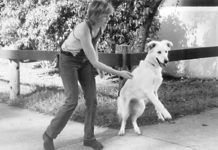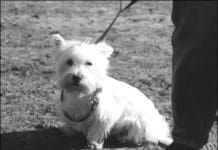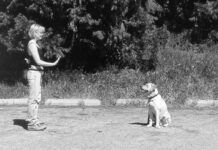Home Search
dog obedience training - search results
If you're not happy with the results, please do another search
Remedial House Training for Dogs
Meet Mollie
Training and Socializing Dog-Aggressive Dogs
Going for a walk with your dog may be one of your favorite ways to exercise and relax, but your pleasant outing can quickly turn into a stressful one if you happen to encounter another dog running loose. If the other dog is threatening or your own dog reacts aggressively, the situation can become downright dangerous. Like most owners of dog-aggressive dogs, Thea McCue of Austin, Texas, is well aware of how quickly an outdoor activity with her dog can stop being fun. Wurley, her 14-month-old Lab mix, is a happy, energetic dog who loves to swim and go running on the hike-bike trails around their home. But when he's on leash and spots another dog, he sometimes barks, growls, and lunges. Since he is 22 inches tall and weighs 60 pounds, he can be hard to handle, says McCue. When he pounced on one little 10-pound puppy
Training Your Dog to Learn
Operant conditioning and classical conditioning, though mostly applied to human psychology nowadays, are structures that were first developed in observing dog behavior. They are somewhat opposite methods of behavioral modification, however both are effective in training animals (and young children). They work simply to reverse bad habits and teach good ones. Read on to learn the difference, and get your dog obeying all your commands, every time.
The First Year in the Life and Training of a Hearing-Alert Service Dog
Meet Lulu. Lulu is a Havanese-mix puppy, just about a year old. In many ways she is a typical adolescent pup: outgoing, social, and full of enthusiasm for life. But there is something special about Lulu. She is in training to be a service dog. When Lulu is fully trained, she will be a hearing-alert dog for her human companion, Sara Walsh.
Training Your Dog to Be Polite
she probably shouldn't be in public until she's had some remedial "downtown hound" lessons.üTeach your dog "leave it
The Benefits of Crate Training Your Dog From an Early Age
I am a huge fan of crate training for dogs. I think the ability to spend an extended amount of time in an enclosed space quietly and calmly is a valuable life skill for dogs. And it certainly has dozens of benefits for us, too. A crate and crate-trained dog ensure that you and your dog will be welcome at most friends' and relatives' homes. I recently stayed at a friendS' house over the holidays, with my foster dog! She doesn't have enough training or self-control to abstain from chasing a strange cat, eating the cat's food, chewing on the furniture, or stealing food off the table, but none of these things happened, because she was happy to spend all of her unsupervised time in their home in her crate.
Training An Older Dog
You've no doubt heard the adage, You can't teach an old dog new tricks." If you have an older dog
Tips on House Training Your Dog
Teaching your dog to eliminate on cue is such a valuable trick" once your dog knows how
Consistent Dog Training With Regards to Men and Women
In general, men tend to be more physical with their dogs, and more assertive, enjoying rough-and-tumble wrestling games and expecting the dog to understand and obey. Women tend to be softer, more into cuddling than wrestling, and take more interest in teaching the dog to understand the complex world of primate (human) communication.
Training Dogs with Hand Signals
Silent cues are useful in any situation where your dog can't hear you, whether he's across a field from you, with you at a parade, if he's deaf, or suffering age-related hearing loss. There are two philosophies about training dogs with hand signals. Some people like to use small, subtle signals, barely visible to the human eye. A tiny finger movement cues the dog to lie down. Another elicits a sit. A small wave sends the dog into heel position. Impressive it appears that the dog is mind-reading!
Understanding Reward Based Dog Training
In the 1950s, behavioral scientist B.F. Skinner developed a number of principles that are applicable to all living things with a central nervous system. He found that animals are likely to repeat behaviors that are enjoyable/rewarding to them, and not likely to repeat behaviors that result in something unpleasant (punishment). Neutral stimuli – things that don’t matter to the animal – don’t have an impact on behavior one way or the other. Skinner demonstrated that humans can use these simple principles to modify an animal’s behavior. Rewards are the most reliable way to deliberately increase an animal’s offered behaviors; conversely, punishment decreases those behaviors. (See “The Four Principles of Operant Conditioning,” next at end of story). We use these behavioral principles in dog training with great success.
Using Shock Collars for Dog Training – Is It Ok?
There is a trainer I know who posts a lot of short videos of her own dogs and dogs owned by clients of her...













